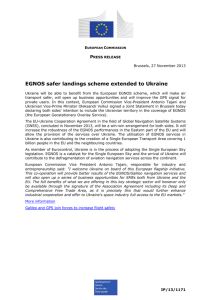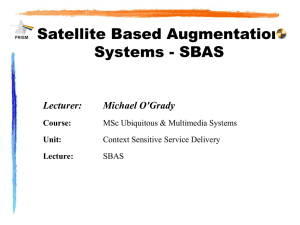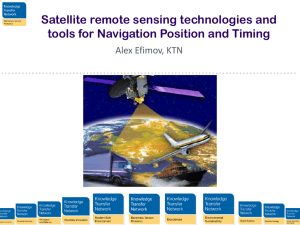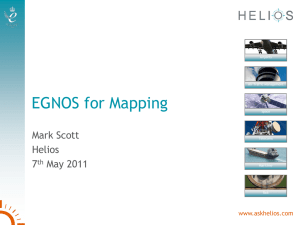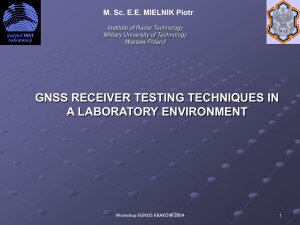Satellite Navigation, Wireless Networks and the Internet Satellite
advertisement
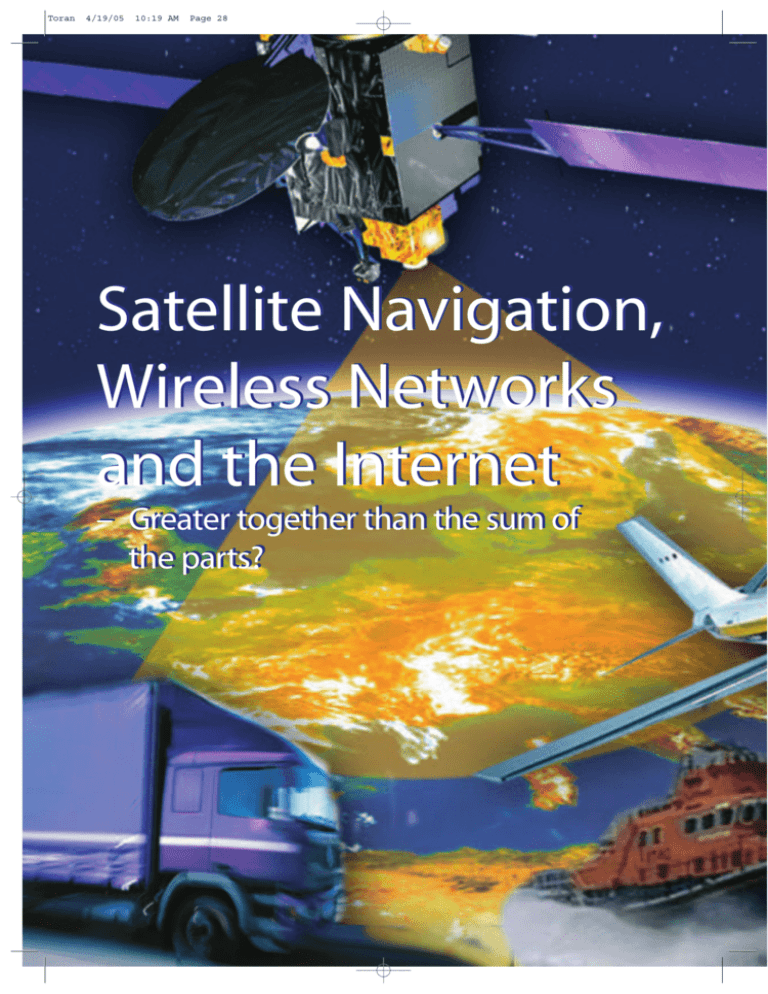
Toran 4/19/05 10:19 AM Page 28 Satellite Navigation, Wireless Networks and the Internet – Greater together than the sum of the parts? Toran 4/19/05 10:19 AM Page 29 Satellite Navigation, Wireless Networks & Internet Felix Toran, Javier Ventura-Traveset, Alberto Garcia, Jean-Luc Gerner, Simon Johns & Juan De Mateo Navigation Department, ESA Directorate of European Union and Industrial Programmes, Toulouse, France O ver the last 20 years, major developments have taken place in parallel in the key technology areas of wireless communications and satellite navigation. Both are gradually becoming indispensable tools in the professional and consumer worlds. Nowadays, major synergies are developing in terms of wireless mobile terminals with a navigation capability, or navigation terminals with wireless communications capabilities. ESA is undertaking a series of activities to support the exploitation of such synergies for the benefit of Europe’s citizens through the provision of new and upgraded services from space. Introduction For the time being, satellite navigation is only known to the public via consumer applications of the US Global Positioning System (GPS). The implementation of a wide range of other potentially very useful GPS-based applications is still hampered by various institutional and technical difficulties. The lack of guaranteed integrity of today’s GPS data is a handicap for a wide range of critical applications, not only those involving the safeguarding of human lives. The limited accuracy and coverage of today’s GPS systems in towns and cities – due to what is known as the ‘urban canyon’ effect – is currently tending to restrict applications to somewhat basic guidance services. esa bulletin 121 - february 2005 29 Toran 4/19/05 10:19 AM Page 30 European Union and Industrial Programmes The EGNOS system is being developed by the ESA EGNOS Project Office located in Toulouse (F), with support from the ESA Directorate of Technical and Quality Management at ESTEC in Noordwijk (NL), which has put a team of experts in place and has set up a European Navigation Laboratory. There is also close coordination with the Galileo Joint Undertaking – responsible for the European Commission’s navigation research programme and the establishment of the Galileo Concessionaire – and with the ESA Navigation Applications and User Services Office, which coordinates all ESA navigationrelated application technologies. Satellite Navigation and Communications – Technology and Services The impact of EGNOS on GPS in terms of improved accuracy. ‘Selective availability’ is the ability of the GPS service provider to intentionally degrade system performance The European Geostationary Navigation Overlay Service (EGNOS) system, the first pan-European Global Navigation Satellite System (GNSS) infrastructure that will begin operating in 2005, is a step forward in reducing such GPS limitations. EGNOS permanently monitors the GPS satellite constellation and provides the users with real-time integrity and correction data for the GPS satellites, thereby enabling guaranteed high-accuracy positioning. EGNOS messages are broadcast over Europe via geostationary satellites, including ESA’s Artemis satellite, and this is an excellent broadcast medium for many applications (e.g. civil aviation or maritime). For other applications such as navigation in urban areas, in 2001 ESA developed the SISNeT technology, which improves urban penetration by providing the EGNOS data to the user through the Internet, thereby making them accessible to any wireless mobile terminal. Today many users are already using this by now well-proven technology, which has already contributed to the emergence of a large number of innovative applications. SISNeT is just one of the many services that combining satellite navigation systems 30 esa bulletin 121 - february 2005 and wireless networks can offer. More generally, ESA is also developing an EGNOS product-dissemination concept based on the EGNOS Data Access System (EDAS), which will be operational at the end of 2005, making full synergy between mobile and navigation services possible. Technology synergies The integration of the communication and satellite navigation functions has major benefits at the user level. The satellite navigation function can benefit from the support data provided through the communications channel for better access to the wide-area differential and integrity GPS corrections provided by EGNOS. This avoids the problems of decreasing EGNOS service area corresponding to the current baseline, with 34 monitoring stations (Courtesy of Alcatel Space) www.esa.int Toran 4/19/05 10:19 AM Page 31 Satellite Navigation, Wireless Networks & Internet GNSS performance due to ‘shadowing’ of the EGNOS geostationary satellites, or in some indoor environments. Such links also enable the user terminal to access the latest satellite ephemeris and SBAS messages on request, which dramatically decreases the receiver’s Time To First Fix (TTFF), i.e. the time needed to start providing position. Such synergies are particularly beneficial for users at high latitudes, who may easily experience a low satellite visibility, and users in suburban and urban ‘canyons’. On the other side, the communications function benefits from the position information, allowing power adjustment based on distance and network resource optimization, in addition to the primary user benefit of access to localisation-based services for which huge range of applications are being developed. The ESA SISNeT Technology EGNOS will primarily broadcast widearea/integrity GPS corrections through geostationary satellites. To provide complementary transmission links, ESA has launched specific activities to assess and demonstrate the feasibility of broadcasting the EGNOS signal by other means, such as standard FM radio signals or GSM mobile phones. As early as 2001, ESA provided access to the EGNOS Test Bed messages via the Internet. A new product was thereby born called SISNeT (Signal in Space through the Internet), which proved to be full of potential. In February 2002, the prototype SISNeT service was made accessible worldwide via the Internet, offering immediate advantages to the GPS landuser community. Numerous users equipped with a GPS receiver and wireless Internet access have exploited the SISNeT service and benefitted from the EGNOS Test Bed augmentation signals, even in situations where the geostationary EGNOS satellites were not visible. Extensive market studies have confirmed the value of the future convergence and merging of satellite navigation and wireless networks into compact mobile devices (e.g. mobile phones including a GNSS receiver) to offer GNSS-based Location Based Services www.esa.int (LBS). Such studies serve to underline the great potential of SISNeT technology, which is already being applied in many industrial developments under ESA contract. The EGNOS Data Access System (EDAS) In addition to providing the Internet SISNeT service since 2002, ESA has also performed a number of other feasibility studies on dissemination of the EGNOS messages via other non-space means, such as DAB (Digital Audio Broadcasting) or RDS (Radio Data Service). The high degree of success achieved in those studies has motivated the Agency to design a professional evolution of the SISNeT service to match the needs of a broad spectrum of dissemination technologies. This evolution, called the EGNOS Data Access System (EDAS), will constitute the main interface point for multimodal Service Providers supplying the EGNOS products in real-time, within guaranteed delay, security, and safety performance boundaries. Application Service Providers will then exploit these EGNOS products to offer a variety of superior services to end users. EDAS will be developed as part of the GNSS Support Programme Step 1, with a view to having an EDAS system operational before the end of 2005, thus opening the way for its commercial exploitation by the EGNOS Commercial Operator. The extensive suite of services that could be spawned from EDAS includes the provision of: – SISNeT services – EGNOS pseudolites – EGNOS services via the Radio Data System (RDS) – EGNOS services via Digital Audio Broadcasting (DAB) – Wide Area Real-Time Kinematics (WARTK) services, allowing decimetre level positioning accuracies at continental scales – Accurate ionospheric monitoring – EGNOS performance information in real-time – Archiving of EGNOS messages – EGNOS corrections in standard RTCM SC104 format, ready for use by DGPS receivers. Demonstration Activities A PDA-based SISNeT Receiver To verify the feasibility of the SISNeT concept, ESA placed a contract with the Finnish Geodetic Institute to develop the World’s first SISNeT receiver. Based on a conventional Personal Digital Assistant (PDA) pocket-PC device, it includes both a low-cost GPS card and Internet access via a standard GSM/GPRS wireless modem. Special software combines the GPS measurements with EGNOS corrections obtained from SISNeT via the Internet. Almost any commercial GPS software can be enhanced with SISNeT positioning in this way. SISNeT handheld receiver based on the Siemens SX45 mobile phone/Personal Digital Assistant (PDA), developed by the Finnish Geodetic Institute (FGI) under ESA contract. This was the first device to demonstrate the enormous potential of integrating EGNOS, Wireless Networks and the Internet in a single unit esa bulletin 121 - february 2005 31 Toran 4/19/05 10:19 AM Page 32 European Union and Industrial Programmes During field testing in Finland, the new receiver delivered horizontal positioning accuracies of 1-2 metres and vertical accuracies of 2-3 metres. In a further step, the device has been integrated into a Siemens SX45 mobile phone. SISNeT-based Navigation for the Blind This demonstration activity assessed the benefits of using the SISNeT concept to help blind people in a city environment. The project was based on an existing personal navigator for the blind, known as TORMES, developed by the Spanish company GMV Sistemas and the Spanish organisation for the blind (ONCE). It includes a Braille keyboard, a voice synthesizer, a cartography database and navigation software. The positioning is based on a conventional GPS receiver, and hence suffers the typical signal-shadowing problems in urban areas. The improvement provided by the integration of EGNOS data via SISNeT was tested in the outskirts and downtown areas of Valladolid in Spain. The results were excellent, with a significant improvement in both accuracy and service availability, which will allow blind pedestrians to be forewarned of obstacles in the street. Being connected to the Internet could also give TORMES important added-value, allowing users to TORMES: A personal navigator for the blind, enhanced with SISNeT capabilities, developed by GMV Sistemas (Spain) and ONCE (the Spanish Organisation for the Blind). This device has highlighted the immense benefits that the synergy between Satellite Navigation and Communications can bring to visually impaired people not only receive information but also send relevant data back to the system, e.g. notification of a blocked street or pavement. SISNeT-based Bus-Fleet Management This activity was designed to demonstrate the improvements that EGNOS can provide for an urban bus operator. A handheld SISNeT receiver combining a GSM/GPRS modem and a GPS receiver, developed by the French company Navocap under ESA contract, was tested on a bus operating in the French city of Toulouse. The route included both residential and downtown areas, allowing the robustness of the unit to be tested for different degrees of satellite visibility. The results were quite promising, indicating that SISNeT could be a very adequate complement to (or even a replacement for) the differential GPS systems currently employed, which need a costly infrastructure. ShPIDER: A Professional HighPerformance SISNeT Receiver An integrated professional device called ShPIDER, which includes a GPS receiver and a GPRS modem, has been developed by GMV (Spain) under ESA contract. Its navigation algorithms allow significantly improved positioning accuracy and SISNeT receiver based on a PDA device, integrating a GPS receiver and a wireless link to the Internet in a single box. It has demonstrated the benefits of the ESA EGNOS-SISNeT technologies for urban bus-fleet management systems. This receiver has been developed by Navocap (France) under ESA contract 32 esa bulletin 121 - february 2005 www.esa.int Toran 4/19/05 10:19 AM Page 33 Satellite Navigation, Wireless Networks & Internet other cases, the communication link was used to help the end user to improve their positioning accuracy and integrity by means of an TRAN service centre that has access to EGNOS either by direct line-ofsight or a SISNeT connection, and is able to re-compute and send back the end-user navigation solution. Several demonstrations have shown the EGNOS performance via TRAN to be very close to that when using geostationarysatellite data, despite the extra delay introduced by the communication link. The Project has confirmed EGNOS as a very cost-efficient alternative to a number of existing local-area GPS augmentation systems. ShPIDER, a professional high-performance SISNeT-powered EGNOS receiver, developed by GMV (Spain). It integrates a GPRS wireless link to the Internet and a GPS receiver and has been tested in the context of both bus-fleet management in Spain and the EGNOS TRAN Project in Italy availability compared with GPS-only solutions. The benefits are even more pronounced for low-visibility conditions, such as in cities. The ShPIDER receiver has also been tested in the framework of the bus-fleet management trial in Valladolid and the ESA EGNOS TRAN project (see below) in Rome, showing promising results in both cases. Since most applications addressed were safety-critical, the use of the terrestrial link has multiple benefits. For example, the communications link could be used to resend the EGNOS information encapsulated in the appropriate format (RTCA original, GBAS, RTCM) in a manner transparent to the end user. In EGNOS Dissemination over RDS ESA has also studied the feasibility of EGNOS dissemination using FM Radio Data System (RDS) signals, through a contract with TDF (France). A laboratory chain was set up in which EGNOS messages from the ESA SISNeT service were broadcast via RDS signals. A key challenge was the need to reduce the amount of information to be broadcast in order to fit the RDS bandwidth available. This was solved by developing selective filtering algorithms able to extract only the information relevant to the user, depending EGNOS Dissemination through Terrestrial Networks - The EGNOS TRAN Project In the framework of its Advanced Research in Telecommunications Programme (ARTES), ESA launched a number of activities focussing on EGNOS signal broadcasts for areas with weak spacesignal reception. Several solutions were tested through the EGNOS TRAN project (EGNOS Terrestrial Regional Augmentations Networks), all of them relying on the use of terrestrial networks as EGNOS augmentations. Summary of applications developed in the context of the EGNOS TRAN Project www.esa.int esa bulletin 121 - february 2005 33 Toran 4/19/05 10:19 AM Page 34 European Union and Industrial Programmes The GlobalWave system architecture on his/her position. The results showed typical horizontal accuracies of 1-3 metres, demonstrating both the feasibility and potential of RDS EGNOS broadcasting. EGNOS Dissemination over DAB The results with RDS encouraged ESA to think about other possible means of EGNOS transmission. The focus was on Digital Audio Broadcasting (DAB), a technology that allows the listener to receive CD-quality radio programmes without signal distortion or interference. Moreover, DAB is able to carry not only audio signals, but also text, pictures, data and even videos to the receiving set, and is being implemented and exploited worldwide. The concept was tested in Germany, through an activity performed by BoschBlaupunkt (Germany) under ESA contract. The EGNOS message was obtained via the SISNeT service and transmitted over DAB. A DAB car radio system received the signals and extracted the EGNOS data, which was decoded and applied to a GPS receiver through an integrated hardware- software platform. A tour through peripheral, residential and downtown areas revealed a significant improvement in terms of positioning accuracy with respect to GPS-only applications. Integrated Receiver Technologies ESA is also supporting several projects in the receiver-technology domain. One of the first is to develop and demonstrate a small, low-cost EGNOS/Inmarsat terminal that is capable of computing safe positions and communicating them to the web for a variety of safety, navigation and other applications in the maritime domain. The terminal is being developed by TransCore-GlobalWave (Canada) based on a commercially available product. It receives GPS/EGNOS navigation signals and computes position which, together with other sensor and message information, is communicated back to the base station using the Inmarsat-3 satellites, and to the customer via the Internet. The terminal’s position is monitored through the GlobalWave application server, located at the end-user’s premises. The integrated terminal thereby provides a two-way communications function between the mobile terminal and the web, with the service area determined by Inmarsat-3 satellite coverage. Another project is the development and demonstration of an Integrated Navigation/Mobile Communication User Terminal based on the TETRAPOL system. TETRAPOL is a fully secure, digital mobile communications network (GPRS-like), designed to meet the growing needs and expectations of highlydemanding Professional Mobile Radio (PMR) users, such as public safety services, transport, or industry. The terminal supplies the actual EGNOS-based position information via the TETRAPOL communication network to an Automatic EGNOS service-coverage expansion to the MEDA region, thanks to the addition of four monitoring stations to the EGNOS baseline. This enhancement is planned for 2006 (Courtesy of Alcatel Space) 34 esa bulletin 121 - february 2005 www.esa.int Toran 4/19/05 10:19 AM Page 35 Satellite Navigation, Wireless Networks & Internet EGNOS V2.1 (in 2006) EGNOS V2.2 (in 2007/8) EGNOS V2.3 (in 2008/9) Provision of operational non-SoL services (MT0/MT2) Provision of EGNOS time service Broadcasting of EGNOS messages in L5 MT28 provision Upgrading RIMS L1/E5 to be able to also process Galileo IPPs to improve IONO measurements (TBC) Provision of EGNOS products through nonGEO means (INSPIRE and EDAS) Expansion of EGNOS services in MEDA region (North Africa and Middle East, Mediterranean countries) Expansion of EGNOS services in Africa Expansion of EGNOS services to EU accessing countries Avail. improvement by modern RIMS RX (L2C) SAR return link & I/F COSPAS/SARSAT (TBC) STEP 1 Vehicle Localization (AVL) server. The end-user is able to track and guide several terminals on an AVL display and communicate with them via the voice and data channels of the TETRAPOL system. The navigation module is able to acquire assisted GPS and assisted EGNOS information via the communication system whenever the clear view of the satellites is obstructed. The main applications are the tracing and tracking of mobile targets, and security and emergency location determination. A demonstration phase has verified the system’s performance. The communication part of the project is under the responsibility of EADS Telecom, whereas the navigation part is being implemented by IMST, Fraunhofer and IFEN. TeleConsult is responsible for the demonstration phase. Future Developments and Evolution At the time of writing (October 2004), the deployment of the EGNOS infrastructure is quasi-complete, with all four Master Control Centres (MCC) and all six Navigation Land Earth Stations (NLES) already in place. 31 of the 34 RIMS Ranging and Integrity Monitoring Stations) are now installed, and all three EGNOS geostationary satellites are www.esa.int STEP 2 already successfully transmitting EGNOS test signals. The test transmissions started in December 2003, and the qualification tests are now approaching completion with the EGNOS Operational Readiness Review, which will open the way for initial system operations, scheduled for early 2005. In parallel with the start of operations, EGNOS already plans to respond positively to today’s dynamic GNSS environment. Since 1998, when the original EGNOS mission requirements were set, the launch of the Galileo Programme and the planned modernisation of the GPS and WAAS systems have brought further opportunities for EGNOS. In this global strategic race to promote and benefit from future GNSS applications, the Council of the European Union confirmed in June 2003 that, as an integral part of the European Satellite Navigation policy, EGNOS services should be extended within a long-term perspective to other parts of the World. In response to that mandate, a GNSS Support Programme was defined by ESA and the European Commission – Step 1 covering the 20052006 timeframe and Step 2 the 2006-2008 timeframe – to further maximise the potential benefits of GNSS for Europe’s citizens, and in particular to define and implement the most appropriate evolutions of the EGNOS system to best prepare for the Galileo services to be available from 2009 onwards. Conclusions Since 2000 and the implementation of the EGNOS Test Bed, ESA has been playing a leading role in demonstrations of the potential benefits that European citizens can expect from these technologies. Special attention will continue to be devoted to the future EGNOS Data Access System (EDAS), which will already be operational at the end of 2005, facilitating full synergy between mobile and navigation services. These advanced GNSS services are likely to become essential assets on a day-to-day basis for many Europeans from 2005 onwards, first with EGNOS and later on a worldwide r basis with the Galileo system. esa bulletin 121 - february 2005 35
